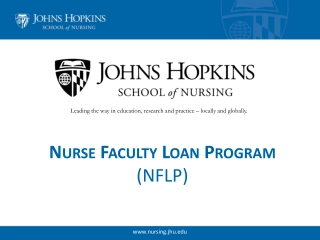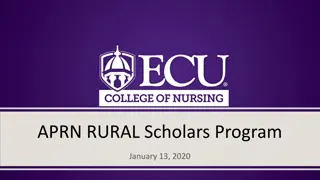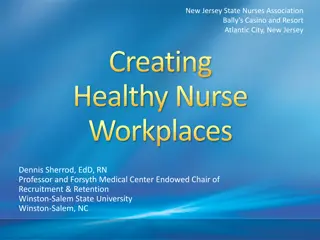Importance of Communication in Nurse-Patient Relationships
Effective communication is a vital tool in establishing and maintaining nurse-patient relationships. It helps in building trust, safety, and acceptance, and promotes a sense of being heard and supported. Communication must be guided by the patients' needs and enable them to feel cared for and understood. Understanding the levels and elements of communication, as well as utilizing different modes of communication, plays a crucial role in providing quality healthcare.
Download Presentation

Please find below an Image/Link to download the presentation.
The content on the website is provided AS IS for your information and personal use only. It may not be sold, licensed, or shared on other websites without obtaining consent from the author. Download presentation by click this link. If you encounter any issues during the download, it is possible that the publisher has removed the file from their server.
E N D
Presentation Transcript
Nurse-patient Relationship Communication A vital tool in establishing & maintaining nurse-patient relationship (families, multidisciplinary team members) Nurse-patient interactions Helps patient recall, describe, clarify Is a lifelong learning process Necessary to build therapeutic communications 2
Communication Nurse-patient relationship - Should be guided by needs Should promote a sense of being heard & supported Should establish trust, safety, & acceptance Should provide feedback patient must feel that the nurse cares about & wants to help 3
Communication Must be able to use self therapeutically Use one s personality consciously Know & understand self Realize that the extent in helping others is influenced by Self-awareness, self-understanding, & beliefs about life, death, etc. 4
Levels of Communication 1. Intrapersonal A. Occurs within an individual 2. Interpersonal B. One to One interaction between 2 people 3. Transpersonal spiritual domain C. Interaction within a person s 4. Small Group D. Interactions with a small number of people 5. Public E. Interaction with an audience 5
Figure 24-1 Communication as active process between sender and receiver. 6
Elements of the Communication Process 1. Referent - 2. Sender& Receiver B. One who encodes & one who decodes the message 3. Message C. Content of the communication 4. Channels D. Means of conveying & receiving message 5. Feedback E. message the receiver returns, (pt. may understand but has questions) 6. Interpersonal variables F. Factors within both sender and receiver that influences communication A. Motivates one person to communicates with another. 7
Modes or Forms of Communication Verbal messages communicated through words & language, either spoken or written Vocabulary Denotative & Connotative Pace Intonation Clarity & brevity Timing & relevance 8
Non-Verbal Communication Personal Appearance Posture & Gait - Facial Expression - Eye Contact - Gestures - Sounds - Territoriality & Personal Space - Touch Zones of touch 9
Communication Zones of personal space Intimate (0 to 18 inches) Ex. Holding Hands Personal (18 inches to 4 feet) Ex. Sitting at bedside Social (4 to 12 feet) Ex. Making rounds, sitting at head of table Public (12 feet & greater) Ex. Lecturing in class 10
Communication Zones of touch Social permission not needed Ex. Hands, arms Consent permission needed Ex. mouth, wrist, feet, Vulnerable special care needed Ex. Face, neck, front of body Intimate great sensitivity needed Ex. Genitalia 11
Communication Symbolic communication The verbal & non-verbal symbolism used by others to convey a meaning Art, music Metacommunication A broad term that refers to all factors that influence communication Incongruence in verbal & non-verbal communication Often warrants further investigation 12
Professional Nursing Relationships Nurse-patient Nurse-Family Nurse-Health Team - Nurse-Community 13
Four Phases of Helping Relationship Pre-interaction occurs before meeting the patient Orientation nurse & patient meet Working nurse & patient work together to solve problems & accomplish goals Termination occurs at the end of a relationship 14
Elements of Professional Communication Appearance, demeanor & behavior Courtesy Use of names Trustworthiness Autonomy & responsibility Assertiveness 15
Communication Nursing Process Assessment Physical & emotional factors Altered health states, inability to communicate Development factors Developmental stage Age Sociocultural factors Culture language Gender 16
Communication Nursing Diagnosis Many patients experience difficulty with communication Lacking skills in attending, listening, responding, or self-expression Inability to articulate, inappropriate verbalization Difficulty forming words Difficulty with comprehension Examples of NANDA Nursing DX: oAnxiety oSocial Isolation oIneffective Coping oCompromised Family Coping oPowerlessness oImpaired Social interaction 17
Communication Planning Goals & outcomes Specific & measurable - Setting of priorities - Continuity of care Collaboration with other health care providers 18
Communication Implementation Therapeutic communication technique Non-therapeutic communication technique Adapting communication techniques - 19
Therapeutic Techniques Active listening SOLER Sharing observations, empathy, hope, humor, feelings Using touch Using silence Providing information Clarifying Focusing Paraphrasing Asking relevant questions _ Summarizing Self-disclosure Confrontation 20
Non-therapeutic communication Techniques Asking person questions Giving personal opinions Changing the subject Automatic responses False reassurance Sympathy Asking for explanations Approval or disapproval Defensive responses Passive or aggressive responses Arguing 21
Communication Evaluation Need to determine whether the plan of care has been successful Nursing interventions are evaluated to determine which strategies or interventions were effective Expected outcomes not met, the plan of care needs to be modified 22
Questions You are invited to attend the weekly unit patient care conference. The staff discusses patient care issues. This type of communication is: A. Public B. Intrapersonal C. Transpersonal D. Small group 23
Question While admitting a patient, during the initial interview a family member tells you, My mom really means that she does not understand her medical diagnosis. The communication form the family member used is: A. Focusing B. Clarifying C. Summarizing D. Paraphrasing 24
Helping relationships is the foundation of clinical nursing practice. Contracts for a therapeutic helping relationship are formed during the: A. Orientation stage B. Working stage C. Termination stage D. Preinteraction stage 25
While taking an admission history from the mother of an 18-month-old being admitted for surgery, the nurse notes that the mother is twisting her rings, running her hands through her hair, and moving about restlessly. When the nurse asks the mother about any problems or concerns, she replies, Everything is just fine. The mother s behavior is an example of: Inappropriate communication Inadequate language skills The violation of personal space Incongruent nonverbal communication 26
Question The nurse asks a patient, Did your husband hit you? This is an example of a {n}: Closed question. Open-ended question. Leading question. Neutral question. 27
Question Which of the following responses would be most appropriate for the nurse to utilize when confronted with a patient that is very concerned or frightened? Let s have a bath now and I ll give you a nice massage. You seem upset. May I sit with you for a few minutes? Most people are afraid at a time like this so just try to relax. Have you asked your doctor when you may be discharged to go home? 28
Question The wife of a dying patient states she is overwhelmed by her husband s illness and doesn t think she can go on much longer. The nurse responds by saying, It must be difficult having a loved one in such critical condition. Would you like to talk about it? This is an example of: Focusing. Clarifying. Summarizing. Providing general leads. 29
Creative Commons License This work is licensed under a Creative Commons Attribution 4.0 International License. Except where otherwise noted, this content by Southern Regional Technical College is licensed under the Creative Commons Attribution 4.0 International License. To view a copy of this license, click https://creativecommons.org/licenses/by/4.0/ Healthcare Careers Work!(HCW) is sponsored by a $2.3 million grant from the U.S. Department of Labor, Employment & Training Administration. TAACCCT Grant #TC- 26488-14-60-A-13. Southern Regional Technical College is an equal opportunity employer and will make adaptive equipment available to persons with disabilities upon request. This workforce product was funded by a grant awarded by the U.S. Department of Labor s Employment and Training Administration. The product was created by the grantee and does not necessarily reflect the official position of the U.S. Department of Labor. The U.S. Department of Labor makes no guarantees, warranties, or assurances of any kind, express or implied, with respect to such information, including any information on linked sites and including, but not limited to, accuracy of the information or its completeness, timeliness, usefulness, adequacy, continued availability, or ownership.























